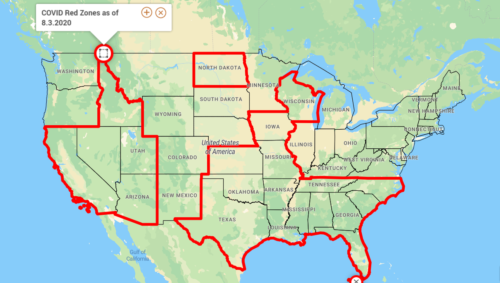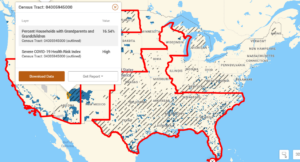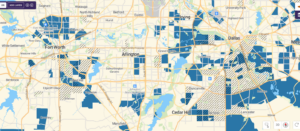The Risk of COVID-19 Spread in Intergenerational Households

Data
Households with Grandparents and Grandchildren
Source
U.S. Census Bureau
Find on PolicyMap
- Demographics
- Households, Families
- Household Type
- Households, Families
The federal government recently designated twenty-one states throughout the South, Midwest and Pacific Northwest as “red zones” indicating an acceleration of COVID-19 infections among residents of those states. Red zones are defined by the federal government as places reporting more than 100 new cases per 100,000 people in the last week.

In addition to emphasizing the need for social distancing and mask-wearing to curb the spread of the virus in these states, Dr. Deborah Birx, one of the nation’s top infectious disease experts, raised concerns about the virus spreading within multigenerational households and urged people in those households to “consider wearing a mask inside their home.”
Intergenerational households have become increasingly common in the United States for the last few decades. A study by Pew in 2018 found that 1 in 5 Americans live in an intergenerational household and that the growth has primarily been driven by Hispanic and Asian households. Researchers have demonstrated the emotional and economic benefits, as well as the challenges associated with living in these types of households, but new risks related to the spread of the coronavirus are making these households particularly vulnerable.
One indicator that can serve as a proxy for multigenerational households is where there are households in which a grandparent lives in the same home as their grandchildren. This could be a household where the grandparent is responsible for raising the grandchildren or where the grandparent lives in the house with their own children and their grandchildren. In either case, as schools, businesses and workplaces reopen, younger family members run the risk of bringing the virus home and infecting their parents and/or grandparents. And as we know from the Severe COVID-19 Index we created for the New York Times, there are areas of the country with people who are more susceptible to severe complications or death from COVID-19 due to underlying health conditions. That Index, which is now available for geographies smaller than counties, can help us to identify places within the current red zone states with high percentages of households where grandparents and grandchildren live in the same home and with a high or very high risk of severe complications due to COVID-19.
At a national level, we can see in blue those areas where more than 10% of households are intergenerational and where severe COVID-19 risk is high or very high (shown as hatch marks). An area that is both blue and hatched meets both conditions as shown across the US, and clearly in the area of Arizona on the map below.

Digging deeper and zooming into a dense area like the Dallas-Forth Worth, TX region provides a very granular look at neighborhoods where there are higher rates of intergenerational families as shown in blue, and where they may also be at severe risk of complications from the virus as shown with the hatch marks.

To understand which states have increasing rates of COVID-19 cases is essential, but the ability to identify those places most at risk within the state, due to family composition and underlying risk factors, can help public officials strategically target sites for testing, areas in need of additional community outreach, or PPE distribution.